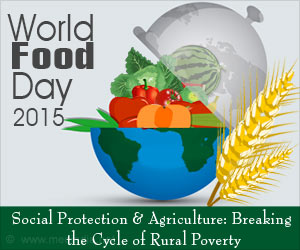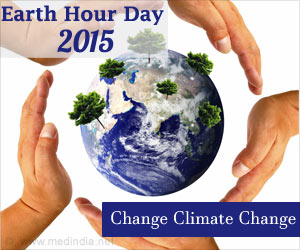The World Food Day is an annual event that encourages people around the world to declare their commitment to eradicate hunger.
Highlights
- World Food Day celebrated on the 16th October is a global movement to eradicate hunger
- One in nine people suffers from chronic hunger
- Theme of World Food Day 2016 - Climate is changing. Food and agriculture must too
The right to food is a basic human right. Every individual has the right to be free from hunger and the right to adequate food. But, due to lack of access, income, and food insecurity, a majority of people around the world suffer from chronic hunger. Ending hunger is a good investment for society.
On the World Food Day, people around the world are encouraged to declare their commitment to eradicate hunger. Public awareness campaigns, hunger walks, and food drives are some of the events that are carried out on the World Food Day. This year, the day falls on Sunday, 16th October, the theme is “Climate is Changing. Food and Agriculture Must Too”.
Number of Hungry People in the World
Everyone feels hungry on a daily basis. Most people are able to satisfy the need. But people who suffer chronic hunger do not have the option of eating when hungry. Hunger can make a person weak and less productive.- In a world of 805 million, one in nine people suffers from chronic hunger
- About 11 million people in the developing countries are undernourished
- Sixty percent of those who suffer from chronic hunger are women
- About five million children below the age of five die due to malnutrition
- A majority of the world's hungry people live in developing countries
- Asia has the most hungry people
- One out of six children in the developing countries is underweight
Causes of Hunger
The cause of hunger is not a shortage of food but rather access to food. The primary causes of hunger include- Poverty
- Poor agricultural infrastructure
- World population
- Food and agricultural policy
- Natural disasters
- Conflict
- Climate change
The world produces enough food to feed everyone. There is 17% more food for each person today than 30 years ago. But the problem is that many people in the world don’t have sufficient income to purchase food or land to grow food.
Climate is Changing. Food and Agriculture Must Too
One of the issues related to climate change is food security. The world’s poorest including farmers and fishers that live in the rural areas of developing countries are the most affected by higher temperatures and weather-related disasters.
It is important to meet the needs of every human being on the planet. The global population is growing steadily, which is expected to reach 9.6 billion by 2050. To meet the demand, the adverse effects of climate change should be adopted in agriculture and food systems. Strategies that will make the agriculture and food systems more resilient, productive and sustainable should be adapted. New methods that produce more food in the same area of land with the minimal use of natural resources should be adopted.
Food waste is a moral issue. One-third of the planet's food goes to waste, which is enough to feed two billion people. Food is wasted at every stage, right from harvesting until it reaches the table. Thus, it is important to reduce food losses through better harvesting, storage, packaging, transport, and market mechanisms before reaching the retail stage.
The FAO has urged countries to address food and agriculture in their climate action plans and invest more in rural development. Strengthening the resilience of farmers, guarantees food security for the hungry population in the world and also reduce emissions. The Paris Agreement on Climate Change and the 2030 Agenda for Sustainable Development, recognized that the fundamental role of sustainable agriculture is addressing climate change, hunger, and poverty.
Conclusion:
No human being in the world should have to experience hunger. People who suffer from chronic hunger have learning disabilities, less productivity, are sick more often and live shorter lives. Hunger leads to global insecurity and environmental degradation. Extreme climate events and financial crisis may affect a person’s ability to feed themselves and their families. These small and large events can be prevented with good policy and resiliency measures. Ending hunger in this generation is possible, but for this to happen, it is every person’s responsibility to give their commitment in their fight against hunger.
References:
- World Food Day Theme - (http://www.fao.org/world-food-day/2016/theme/en/)
- What is World Food Day? - (http://www.worldfooddayusa.org/what-is-wfd)
- Hunger Statistics - (https://www.wfp.org/hunger/stats)
- World Hunger and Poverty Facts - (http://www.worldhunger.org/2015-world-hunger-and-poverty-facts-and-statistics/)
- What is Hunger? - (http://www.un.org/en/globalissues/briefingpapers/food
/whatishunger.shtml) - Hunger - General Information - (http://www.bread.org/what-hunger)















